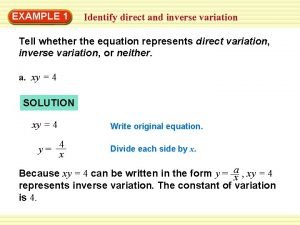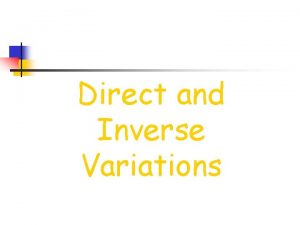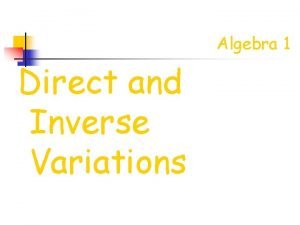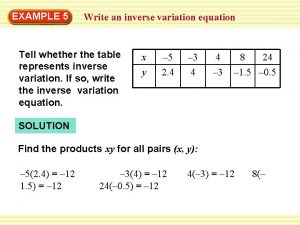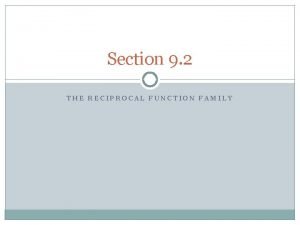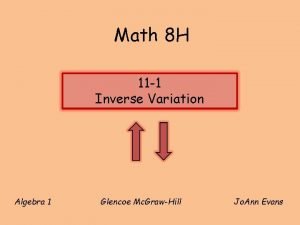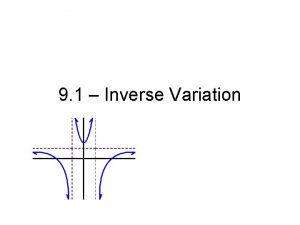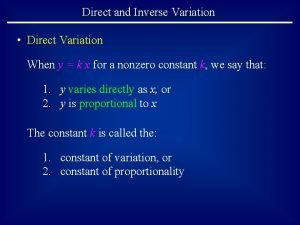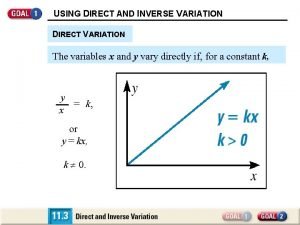1 7 Direct and Inverse Variation The circumference








- Slides: 8

1. 7 Direct and Inverse Variation The circumference of a circle is given by the formula C = 2 r, where r is the radius of the circle. The circumference is always a constant multiple of the radius (multiply the radius by 2 to get the circumference). Because of this, the circumference is said to vary directly as the radius. y varies directly as x means y=kx. k≠ 0 is called the constant of variation. The phrase “y is proportional to x” is also used to indicate direct variation. Some variations involve polynomials of higher degree. One variable can be directly proportional to a power of another variable. y varies directly as the nth power of x means y=kxn. An example of direct variation as a power involves the area of the circle. The formula for the area of a circle is A = r 2. Here, is the constant of variation and the area varies directly as the square of the radius. The phrase “y is inversely proportional to x” is also used to indicate inverse variation. Some inverse variations involve powers of x. In general, 1

1. 7 Direct and Inverse Variation Joint Variation may involve more than two variables. The following table illustrates different types of variation statements and their equivalent algebraic equation. Variation Statement Algebraic Equation 1. y varies jointly as x and z. 2. y varies jointly as x, z and w. 3. V varies jointly as h and the square of r. 4. h varies directly as V and inversely as w. 5. y is directly proportional to x and inversely proportional to the square of z. 6. y varies jointly as w and z and inversely as x. Next Slide 2

1. 7 Direct and Inverse Variation Example 1. Translate each statement of variation into an equation: use k as the constant of variation. Answer: a) A varies as directly as the square of r. b) v varies as jointly as h and the square of r. c) f varies directly as the cube of g and inversely as directly as the square of h. Your Turn Problem #1 Translate each statement of variation into an equation: use k as the constant of variation. a) V is inversely proportional to p. b) P varies as directly as the square root of L. c) y varies as jointly as x and z and inversely as the cube of a. Answers: 3

1. 7 Direct and Inverse Variation Example 2. Find the constant of variation for each stated condition. a) A varies as directly as the square of r, and A = 48 when r = 4. Solution: Translate into an algebraic equation. Since A=48 and r=4, Now solve for k. b) B varies as directly as w and inversely as the square of h, and B=10 when w=5 and h=6. Solution: Translate into an algebraic equation. Replace with given values and solve for k. Your Turn Problem #2 Find the constant of variation for each stated condition. a) V varies jointly as B and h, and V=32 when B=12 and h=8. b) y varies jointly as x and z and inversely as w, and y=15 when x=3, z=10, and w=4. Answers: 4

1. 7 Direct and Inverse Variation Example 3. If y is directly proportional to the square of x, and y=36 when x=3, find the value of y when x=5. Solution: Translate into an algebraic equation. Now find the value of y when x=5. Find k using y=36 and x=3. Answer: Your Turn Problem #3 If y is inversely proportional to the cube of x, and y=27 when x=2, find the value of y when x=3. Answer: 8 5

1. 7 Direct and Inverse Variation Example 4. If p is directly proportional to q and inversely proportional to the square root of r, and p=20 when q=12 and r=9, find the value of p when q=20 and r=16. Solution: Translate into an algebraic equation. Now find the value of p when q=20 and r=16. Find k using p=20, q=12 and r=9. Your Turn Problem #4 If y varies jointly as a and b and inversely as the square of c, and y=42 when a=3, b=8 and c=2, find the value of y when a=6, b=12 and c=3. Answer: 56 6

1. 7 Direct and Inverse Variation Many scientific formulas are expressed as variations such as the area or circumference of a circle. Problems in the homework may contain topics such as electrical resistance, lighting, drug administering, pressure, volume and intensity of light. Don’t be alarmed. Translate the variation statement into an algebraic equation and answer the question. If pressure is an unknown, name it the letter ‘p’. If intensity is an unknown, name it the letter ‘i’. 7

1. 7 Direct and Inverse Variation Many scientific formulas are expressed as variations such as the area or circumference of a circle. Problems in the homework may contain topics such as electrical resistance, lighting, drug administering, pressure, volume and intensity of light. Don’t be alarmed. Translate the variation statement into an algebraic equation and answer the question. If pressure is an unknown, name it the letter ‘p’. If intensity is an unknown, name it the letter ‘i’. Example 5. The frequency of a vibrating string varies inversely as its length. Suppose a piano string 2 ft long vibrates 250 cycles per second. What frequency would a string 5 ft long have? ; F=frequency Solution: Name variables and translate into an algebraic equation. L=length Find k using L=2 and F=250. Now find F when L=5. The frequency of a 5 ft string is 100 cycles per second. Your Turn Problem #5 Body mass index, or BMI, is used by physicians to assess a person’s level of fatness. A BMI from 19 through 25 is considered desirable. BMI varies directly as an individual’s weight in pounds and inversely as the square of the individual’s height in inches. A person who weighs 118 lb and is 64 in. tall has a BMI of 20. (The BMI is rounded to the nearest whole number. ) Find the BMI of a person who weighs 165 lb with a height of 70 in. Answer: The person’s BMI is 23. The End. B. R. 1 -6 -08 8
 Direct and inverse variation graphs
Direct and inverse variation graphs What does a direct variation graph look like
What does a direct variation graph look like (x+y)^4
(x+y)^4 Inverse cariation
Inverse cariation What is the difference between direct and inverse variation
What is the difference between direct and inverse variation Inverse variation equation
Inverse variation equation How to calculate sst in regression
How to calculate sst in regression Inverse variation and the reciprocal function
Inverse variation and the reciprocal function Inverse variation parent function
Inverse variation parent function


